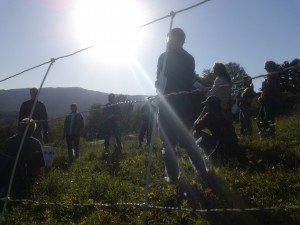by Kimberly Hagen, Pasture Program Grazing Specialist
Quite naturally, springtime is when our minds start thinking about new ideas for the coming season. The outside world’s been dormant, tucked under the snow, and we’ve been tucked inside reading and thinking about how we might change things for the better on our farms for the coming season. The next step is to talk to others about those ideas and start formulating plans for trying something new. Grazing is one of those topics on many farmers’ minds, as grain prices continue to increase and take a bigger bite out of the farm’s profitability. Grazing and perennial pasture have also proven to be one of the more resilient states for land situated in places of risk, such as along a river. The farms along the Mad River in Waitsfield were hit hard by Hurricane Irene, and many of those that farm along the river are looking for a new practice to keep the land healthy and intact for the future.
This spring, twelve farmers met for lunch at the Lareau Farm Inn in Waitsfield and a collaborative presentation by
Mark Cannella, Farm Business Management Specialist at University of Vermont Extension, Kimberly Hagen, Grazing Specialist from the Center for Sustainable Agriculture at University of Vermont Extension, and Mark Marsh, Soil Conservationist at the Berlin office of the Natural Resources Conservation Service. Those attending heard about some of the basic principles of setting up a successful grazing system, shared by Kimberly. These basic principles included information on how plants grow, and how they respond when grazed or clipped, how much time they need to rest before they are grazed again, and how to calculate just how many animals a measured piece of land can support.
Implementing a good grazing system for any livestock operation – whether it is beef, dairy, or small ruminants such a sheep or goats, needs careful attention to details – both outside and inside with good record keeping. Mark Cannella discussed the importance of those records, and using them to understand what practices are beneficial to a farm’s economic condition, and which are not and how to utilize that information to improve the whole farm’s economic health.
For those that were ready to take the next step and implement some new practices on their farms, Mark Marsh shared information about the many programs at NRCS, such as EQIP which can help with cost sharing on new fencing, and water systems, laneways for animals to travel through difficult or wet areas, and support for implementing a grazing plan. There are also nutrient management programs, protecting wet or riparian areas, and programs for protecting grassland birds and other wildlife.
Some of those that attended the March meeting have taken the step to try some new practices on their farm this coming season, and have begun to work with Mark, Kimberly and Mark. Stay tuned as we’ll have more stories as they progress!



Recent Comments